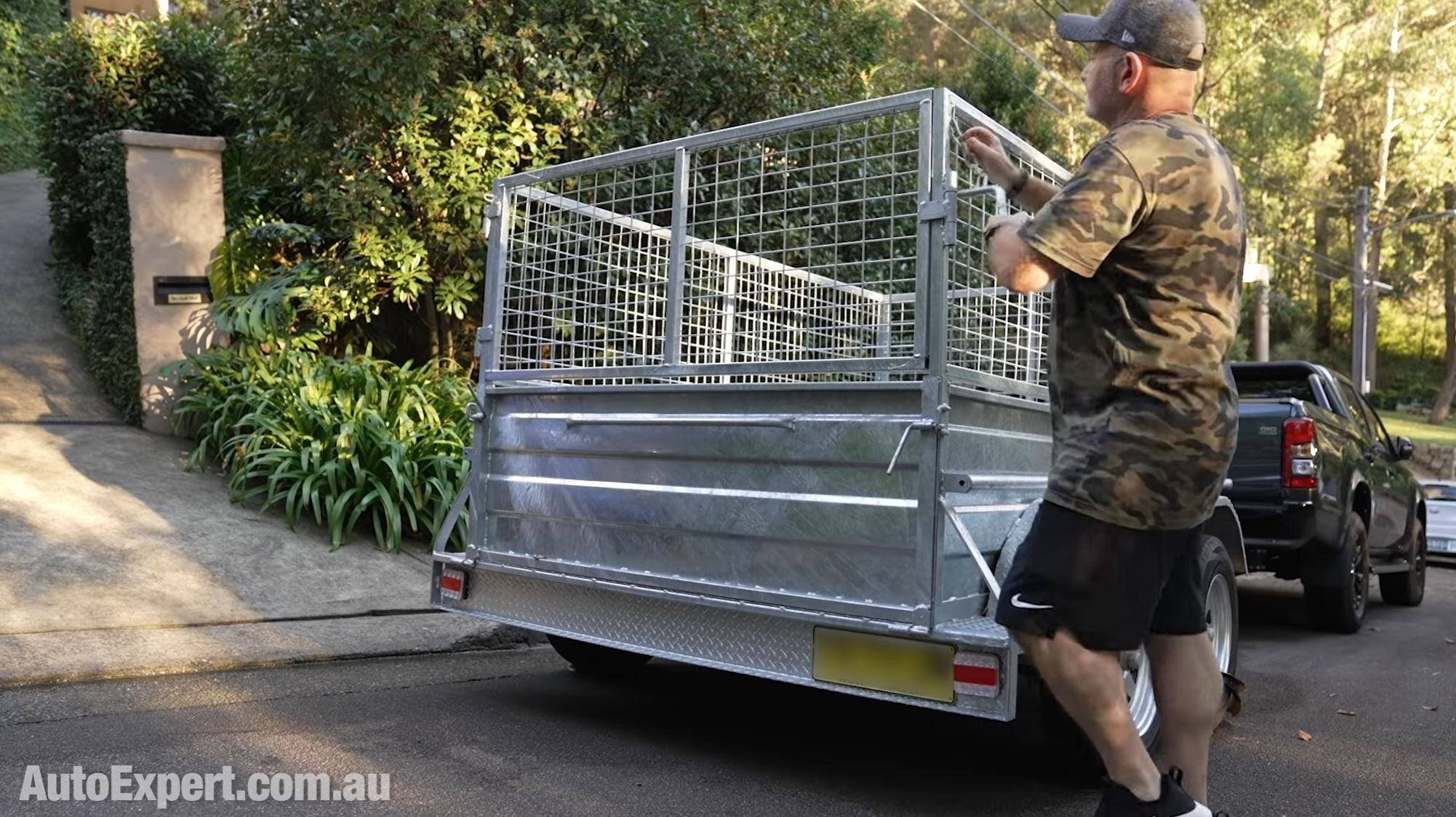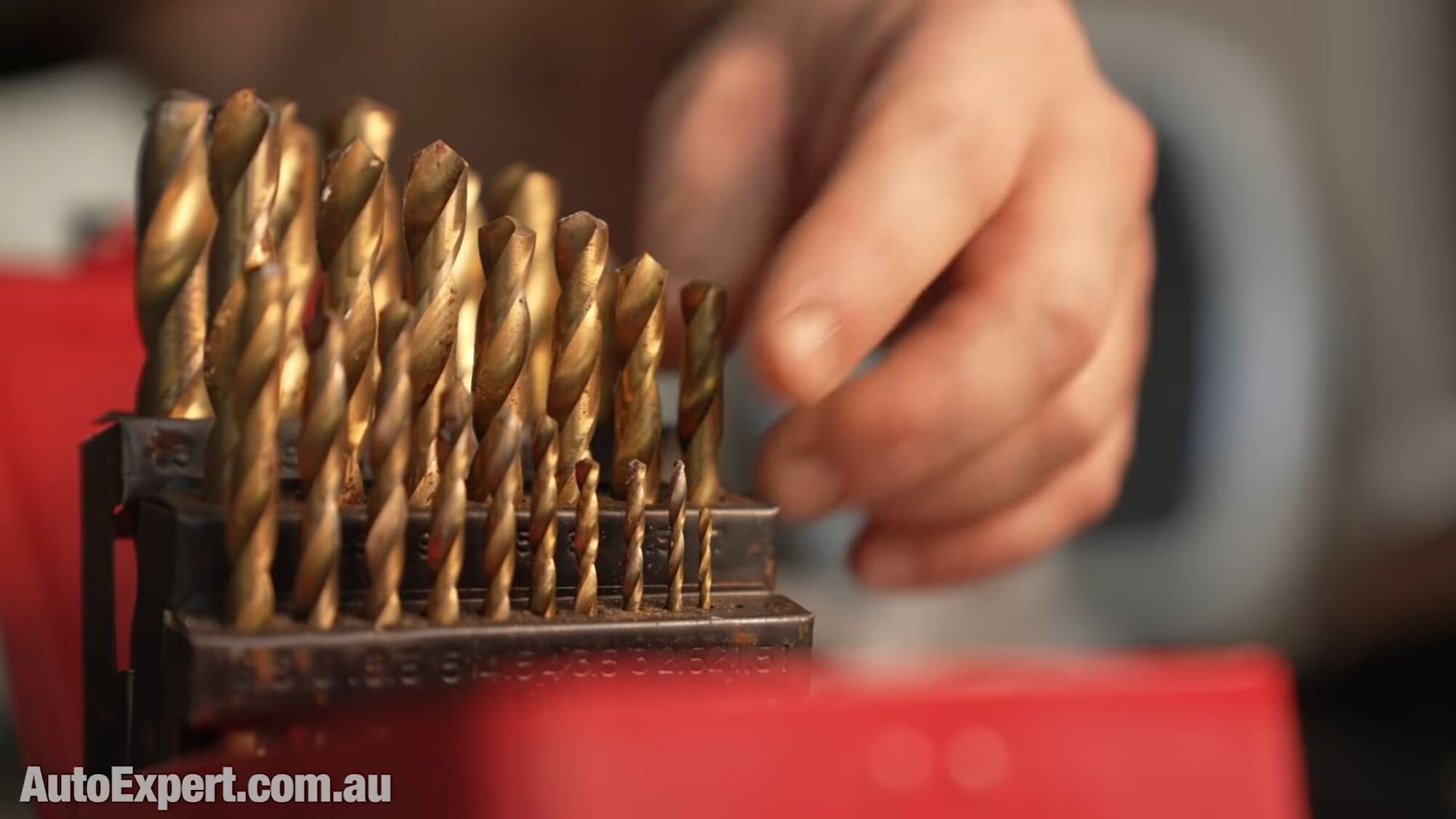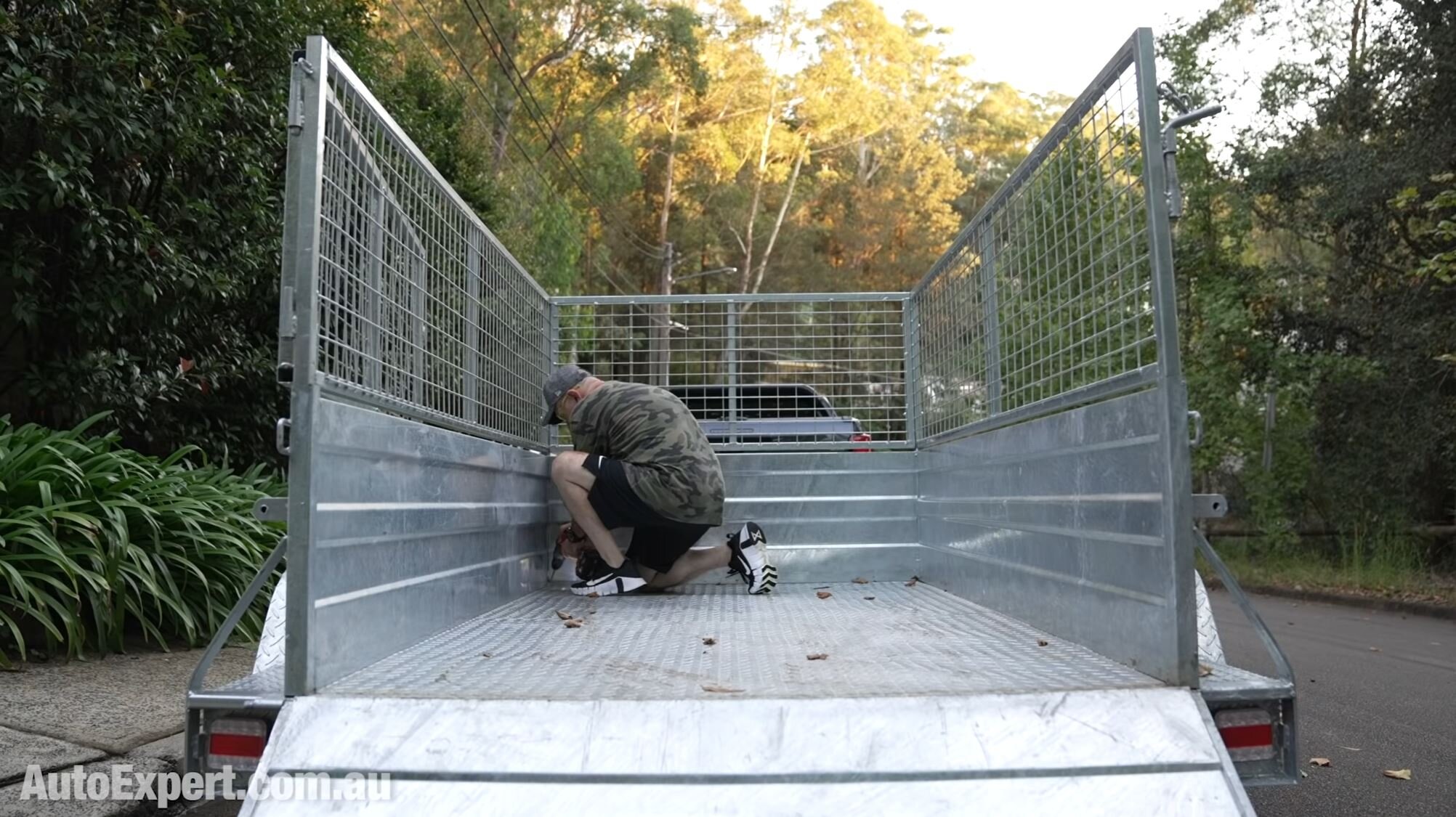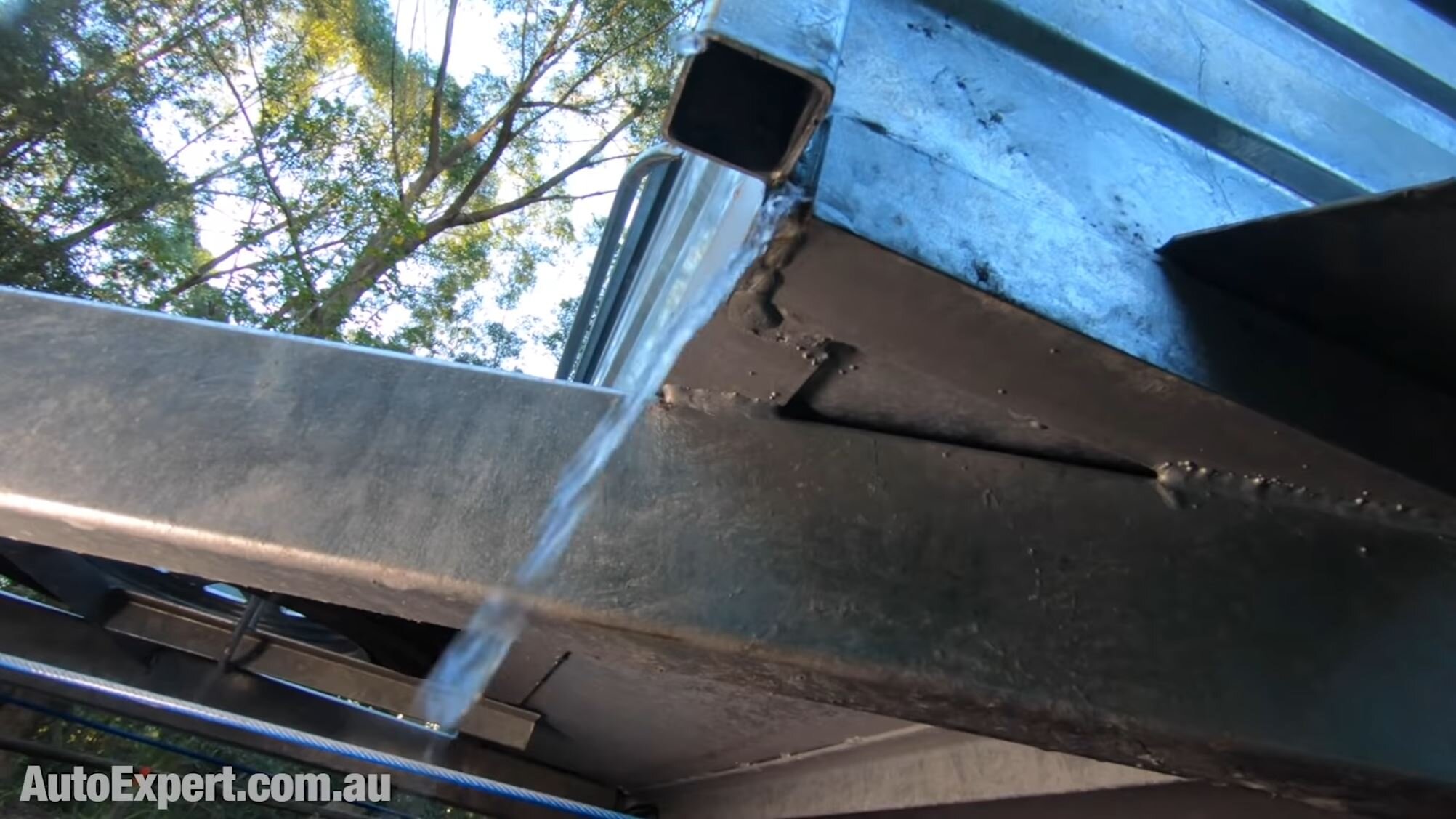The mad science of galvanising, and how it protects your car
Modern cars are galvanised, hence the huge reduction in automotive rust over the past 30 years. Rust is made chemically impossible…
After the recent Biblical flood here, lake Titty-wah-wah formed in my trailer, parked here on a slope. I hate that.
Let us, therefore, drain the swamp before there’s a zombie apocalypse.
Problem solved. But I did this, in conversation, to a person I won’t name, who should know better. He or she replied: Make sure you paint it, because you don’t want your new trailer to rust.
I replied: It’s galvanized, dude. They just looked at me blankly. So let us uncrack the kooky code on what makes galvanising so special at popping a cap in the grille of rust.
Look, the reason we’re talking about this here is: I get one of these plaintive calls for assistance a week, on average. Like, there’s a paint chip on my new car - can you launch the QRF? And I get it, because if you’re older than 1995, cars routinely dissolved in front of your very eyes.
Rust was a cancer that attacked by stealth. It metastasised under the paint (and under the radar) and before you know it, Red October would make like a colander, and you’d be on the hunt for a new car.
This latest one is from a dude named Dan:
Would that be, like, satellite imagery? Or magnetic resonance imagery? Or just a blurry, shaky shot from your iPhone? No need, dude.
So, if you don’t want the upcoming beer garden applied engineering dissertation on exactly how, when, where and why galvanising kicks rust in the nuts, in your car and elsewhere, here’s the short version.
I wrote Dan a prescription for some chill pills. Like, take two, dude, and if that doesn’t work, go down the pub with the boys. Because modern cars are galvanised. They don’t rust because of the cathodic protection. Rust is chemically impossible. (There might be the smallest amount of inconsequential surface corrosion, but it won’t grow. It can’t.)
This quote from the dealer about cars rusting pretty quickly is bullshit. They don’t. You can never rely on a dealer giving you an honest answer. The guy talking to you in the service department is not there because he trained as a metallurgist.
It’s a trivial paint defect on the roof. Get the dealer to fix it in conjunction with the local panel shop, at no cost to you. Then forget about it. Read the full response here >>
MORE AUTOMTIVE TECH TOPICS
Fat Michelin tyres: A sub-$1000 bang-for-buck dynamics hack >>
Hard shackles -Vs- soft shackles in 4WD recovery >>
Best tyre pressures for extended life, boosted safety and maximum grip >>
What is ‘brake mean effective pressure’? >>
What is overboost and how does it work? >>
Engine tech: What are knock sensors? >>
QUICK HISTORY
Galvanizing gets its name from 18th Century necro-maniacal Italian sick bastard Luigi Galvani, who was sitting at the table skinning a frog one day (I’m not making this up) because his wife enjoyed whipping up a little static electricity by rubbing frog skin. (Still not making this up.)
He notes: dead frog’s legs start twitching, as if in life, after making contact with two dissimilar metals, in this case, copper and iron. And he goes: ‘there must be a shitload of electricity down there in the frog’s legs.’ (Still paraphrasing; still not making it up.)
He put this down to his whack-job hypothesis of (quote) ‘medical electricity’ (not making it up), which was big back then. He kinda thought the frog might be the Duracell Coppertop of amphibian power sources. (Not making it up.)
He called it ‘animal electricity’, and decided the post-mortem twitching was a result of electrical fluid in the nerves. Allesandro Volta - the dude they named potential difference after - called the twitchy frog thing ‘galvanism’.
So, Galvani was, obviously, in need of counselling, and (co)incidentally dead wrong, but, despite this, which I did not make up, we named one of industry’s most widespread and effective protective processes after him anyway.
It was actually a French dude named Stanisais Sorel, about 47 years later who figured out that coating steel in zinc actually protected the steel. He was granted a patent on the process, and decided to call it ‘galvanization’ after the frog jolter. Go figure.
If only I could remove the word ‘galvanization’ from the English language. To be replaced by ‘Sorelification’.
My AutoExpert AFFORDABLE ROADSIDE ASSISTANCE PACKAGE
If you’re sick of paying through the neck for roadside assistance I’ve teamed up with 24/7 to offer AutoExpert readers nationwide roadside assistance from just $69 annually, plus there’s NO JOINING FEE
Full details here >>
In the beer garden: Galvanising Vs Rust
Time to earn your beer garden PHD in galvanisation.
If paint is your childhood sweetheart, galvanisation is a three-way. In addition to the barrier protection offered by paint, you get this patina protection, and the electrolytic protection which gets all the news in relation to galvanising.
You can have both kinds of protection as long as it’s done the correct way (three-way first, then sweetheart): Galvanise first. Paint second. Every car you see made this century, is galvanized, then painted.
Galvanising, which is a layer of zinc, functions as a barrier. It deprives atmospheric contaminants from access to the steel underneath. It’s so important. Anything you see that’s galvanised, like light poles, mobile phone towers, Armco, or those vast high-voltage powerlines which keep 132,000 volts separate from human beings - it’s all steel carrying the heavy load. It’s brilliant for that. Except it rusts.
Go out to a Pilbara mine; it’s essentially a big rust bowl which they un-rust in order to get steel out of it.
Galvanisation simply stops the atmosphere trying to turn it back into iron ore. Just like paint only it’s UV stable; you don’t have to worry about galvanization falling apart due to Australia’s harsh UV radiation.
Patina is a very thin layer of chemical reaction to the environmental contaminants reacting with the zinc; the patina is self-healing. Patina is another protective layer keeping the steel safe from rusting. Pro Tip: If you’re going to paint galvanised steel, use an etch primer first, to create a good strong bond with the patina, before painting - otherwise it’s all going to flake off.
Protection number three, which gets all the limelight: Cathodic Protection - AKA ‘sacrificial anode’. They’re essentially the same thing, or at least, they’re flip-sides of the same coin.
Dissimilar metals, like zinc and iron, are in an intrinsically corrosive environment - water, oxygen, electrolytes, actual dingo piss, acid rain (cities) - it’s all essentially an electrochemical reaction.
Basically, the Cathode gets protected, and the Anode gets sacrificed. Zinc is the anode. Iron is the cathode. (You may have also heard of the ‘redox reaction’ or reduction and oxidation. The way to remember this is: ‘Red cats are positive, and reduction occurs there.’
In this electrolytic environment, essentially the water splits into ions and reacts with the zinc, which creates the patina layer.
This is how we protect both ships and cars from rusting. It doesn’t matter if the sheet of steel is electrolytically plated with zinc or hot dipped. The shiny silver stuff is hot dipped, and the gold-looking stuff is plated. Hot dipping simply affords a thicker layer of protection which obviously lasts ‘longer’.
The frog jolter was alluding to the dissimilarity of metals, and we now rate them in terms of their electrolytic ‘activity’.
The most active common metals we have are magnesium, zinc, aluminium and iron.
If you put a more active metal in touch with a less active metal, the more active metal will sacrifice itself and the less active will be protected. Zincalume sheets of roofing use a combination of zinc and aluminium.
Tin is interesting. It’s a layer of protection which relies on complete integrity of the tin itself as an envelope around the underlying steel.
They even use ribs to improve structural integrity for less thickness of material. If you cut out a piece of this tin can and nail it to the fence, it will eventually rust because steel is the more active metal and will sacrifice itself for the tin.
This is one-inch nominal bore galvanised water pipe, manufactured with thread on one end.
And to make a spindle stub axle was a piece of threaded rod. The cut end of the water pipe has zero corrosion despite sitting in water for weeks on end. Whereas my off-cut of threaded rod has, over time, gotten worse for surface rust which is the be expected as it’s untreated mild steel.
The problem with paint is it needs 100 per cent coverage integrity to be effective at protecting. This was what happened with old cars - as soon as you got a stone chip or a scratch or some kind of defect, corrosion would burrow in, blister and before you know it, rusty panels need replacing.
But galvanising means that even if you do get minor defects to the paint protection, it doesn’t really make a difference to the protective mechanism. So little stone chips, tiny scratches, even if they get through the paint, through the patina and even through the zinc layer to expose the underlying steel, there’s still a great deal of localised protection on offer.
Part of the Furniture
Today of course, galvanizing is ubiquitous. It’s actually quite difficult to walk out the door without tripping over something that’s galvanized. All those road signs, held up on galvanized posts, the Armco railing designed to catch Rowan Atkinson’s next supercar, all those 132kV power transmission towers, maybe even the roof over your head, and/or your shed in the backyard.
Galvanized steel lasts for decades in Australia. All the way from the coast to Dingo Piss Creek.
What does this mean for you? Well, you can fabricate galvanized steel without worrying too much about corrosion, because even if the steel is exposed, minor exposure from cutting and drilling is still electrochemically protected by the zinc. That means those two drainage holes I just drilled in my trailer definitely don’t need treatment.
This kind of protection is the total opposite of painted steel - where the most minor defect is a pathway for contact with oxygen gas, water and some slimy electrolyte. And when that happens, rust forms under the paint and before you know it there’s a rusty blister down there, the size of a ripe zucchini.
This is kind of important for every car owner to realise, because modern cars are galvanized, which explains the huge reduction in automotive rust over the past 30 years. Modern cars still rust, but they rust a lot slower than older cars, which were not galvanized.
Essentially we’ve got the Japanese to thank for this. See, back in the ‘70s and ‘80s in Australia, the car market was essentially American. It was all Ford and Holden, which means: we did business the way America did business, and the US was quite happy to throw car owners under the ‘rusty’ bus after just a few short years, rolling around.
And then along came Japan - which has a lot of salty coastline relative to its land mass, and it started introducing galvanized cars in America. They didn’t rust as much, and consumer demand kind forced the hands of the US Big Three automakers to introduce galvanising. And the rest is history.
Fast-forward to today: all new cars are galvanized in developed markets, globally. Even Australia. So, stone chips and minor scratches are not the problem they once were. You can repair them for aesthetic reasons if you want to, but there’s no need to obsess about it from a rust protection point of view, because of the magic frog-jolting action of cathodic protection.
Major damage - where lots of zinc comes off, in the manner of frogskin in the Galvani household on a Friday night, after a few Chiantis, that’s gunna rust. So, should you neck a few scoobs one evening and decide to buff your wanking chariot with a 40-grit flap-disc, until the battery in your angle grinder sucks on a dry tank, that’s gunna be a problem.
The best corrective measure there is to prime it all up with a zinc-based primer, and re-paint, preferably with a pressure pack can (or cans). They’ll probably do a feature on you on 4WD 24/7. Legend. Hectic.
And, finally, I always get some Canadian telling me (Once again, paraphrasing): ‘You don’t know shit, you brain-dead roo-rooter. They salt the roads here in out absolute-zero winters. My car disintegrates before my very eyes.’ (Or words to that effect.)
Yeah, salt is a powerful electrolyte in water. It accelerates the reaction. Once the zinc is consumed it gets in on the steel, and then it’s all over. So, in highly electrolytic environments the countermeasures are: A) Paint the galvanization to form an additional barrier, and B) Wash regularly to remove excess salty electrolyte. Do that. Approved.
Also a good idea if you think driving your CMD-spec 4X4 through seawater is a good idea.
Cars used in these corrosive environments are certainly gunna rust a lot quicker than those that only ever run around New Mexico (or most of Australia). In drier places, especially cities, the main attack on zinc is from acids that form from sulphur dioxide in the air. Because: Pollution. Acidic rain, basically.
Did I forget anything? If you’re a materials scientist, or a metallurgist, or an industrial chemist, please let me know in the comments. I’d welcome your input. Also keen to hear from you, if you are essentially unqualified but you suffer from the Dunning-Kruger effect. That’s always entertaining, too.











